39°54′08″N 45°14′51″E / 39.90222°N 45.24750°E
Aghnjadzor
Աղնջաձոր | |
|---|---|
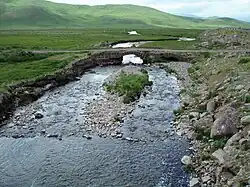 Silk Road bridge at Selim Pass near Aghnjadzor | |
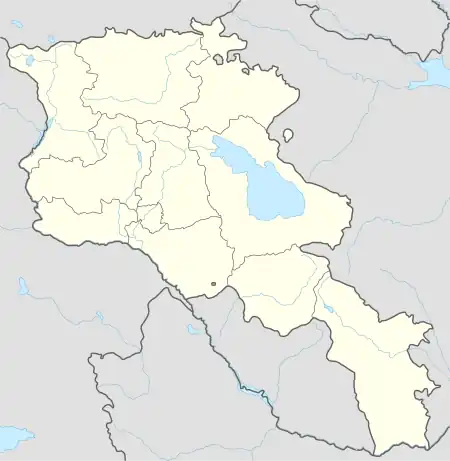 Aghnjadzor  Aghnjadzor | |
| Coordinates: 39°54′08″N 45°14′51″E / 39.90222°N 45.24750°E | |
| Country | Armenia |
| Province | Vayots Dzor |
| Municipality | Yeghegis |
| Population | |
| • Total | 412 |
| Time zone | UTC+4 (AMT) |
| Aghnjadzor at GEOnet Names Server | |
Aghnjadzor (Armenian: Աղնջաձոր; Azerbaijani: Ağkənd) is a village in the Yeghegis Municipality of the Vayots Dzor Province in Armenia.[2] It is located 17–18 km northwest of the Province center. The village had a mixed population of Azerbaijanis and Armenians before the exodus of Azerbaijanis from Armenia after the outbreak of the Nagorno-Karabakh conflict.[3]
Name
The historical name of the village has been forgotten. It has been traditionally testified that in ancient times it was called Drunk (Trunk) and Dezpanart. In the 19th-century records, it is mentioned as Aghkend or Yengija, names inherited from Turkic tribes. Then it was called Lernantsk, and in 1968 it was renamed Aghnjadzor.
History
The village's historical references date back to the 13th and 14th centuries. Over time, it has been known by various names such as Yengicha, Drunk, Aghkyand, and Lernantsk, which were influenced by its geographical location to the south of the Vardenyats mountain pass. In 1968, the village was officially renamed Aghnjadzor. Historically, it served as the estate of the Orbelians, and this era is regarded as the most prosperous period in the region of Vayots Dzor.
Road construction was of great importance for the economic life and the development of trade, as it brought considerable benefits to the country's owners through the passage of caravans. IBesides customs duties, they also profited from trade itself. The Davrezh-Partav transit road passed through this area. Landlord ishkhans took great interest in ensuring the safety of the road and providing suitable accommodations, fodder for cattle, barns, and other necessary facilities for travelers. In 1332, ishkhan Chesar, the son of Liparit Orbelian, built the Sulema (Selim) caravanserai, which is located on the highest part of the mountain pass bearing the same name. This caravanserai consists of three vaulted rooms built with hewn stones.
Another widespread legend exists among the locals. It is said that Smbat Orbelian, having lost his son in the treacherous snowstorms of those mountains, erected the caravanserai as a memorial to his son. It served as a shelter for travelers caught in snowstorms allowing them to stay there until the weather improved and they could safely continue their journeys.
Geography
Aghnjadzor village is located 17.2 km northwest of Yeghegnadzor city. It is situated at an elevation of 1630–1675 m above sea level.
Climate
The climate is moderately hot and dry, with hot summers and cold winters. The amount of annual precipitation is 400–450 mm.
Population
The material cultural monuments preserved in the village serve as evidence of its prosperity and bustling population during the prosperous Middle Ages, particularly under the governance of the Orbelian ishkhans. However, due to forced displacement organized by Abbas the Great, Armenians were compelled to leave the village. In 1829, during the Russo-Persian War, a significant influx of population occurred as Armenians migrated from Khoy and Salmast gavars. Between the years 1925 and 1927, Armenians from neighboring villages, Karaglukh and Taratumb, relocated and settled in this village.
The population dynamics of Aghnjadzor over the years:[4]
| Year | 1897 | 1926 | 1939 | 1959 | 1970 | 1979 | 1989 | 2001 | 2011 |
|---|---|---|---|---|---|---|---|---|---|
| Population | 670 | 300 | 621 | 577 | 502 | 478 | 384 | 449 | 412[1] |
Occupation
The village has 137 households.
The village specializes in animal husbandry, focusing on the breeding of both large and small livestock. 167 ha of agricultural lands are grasslands. Additionally, there are 894 hectares of pastures. The community is also engaged in arable farming, fruit cultivation, and beekeeping. They cultivate various grains and fodder crops as well.
Historical and cultural sites
Near the village, the Church of the Holy Mother of God, the fortress of Sulema, the caravanserai of Aghnjadzor, built in 1332, can be found.
Situated 4 kilometers north of Aghnjadzor there are the ruins of the Kapuyt berd (Blue fortress), khachkars (9–14th centuries) and bridges (13–15th, 18–19th centuries).
There are two caravanserais, a settlement, a cemetery with khachkars, and a church in Aghnjadzor.
Khachkarer
Situated approximately 1.2 km northwest of the village center, this location is known as Khachkarer (Cross-stones). In this area, the remains of a medieval cemetery from the 13th to 14th centuries have been conserved, along with a few barely noticeable house sites. Additionally, there are also several scattered and fragmented khachkars (cross-stones). That is why the place is called Khachkarer (Cross-stones).
Caravanserai
Located 2.2 km north of Aghavnadzor, there stands a building with a one-nave design. Internally, a semicircular vault is supported by vault-bearing arches, which rest upon six pairs of wall pillars. The only entrance is opened from the facade facing south-west, which has been collapsed for a long time. The entire construction is crafted from finely hewn basalt stones. Its external dimensions are 23.3 × 10.6 m. Dim lighting was provided by a pair of openings in the roof. While no inscriptions are found on the preserved parts of the walls, the architectural characteristics indicate that the caravanserai was likely built at the end of the 13th century and at the beginning of the 14th century.
Cemetery with cross-stones
On the southwestern hillside, around 140 meters southeast of the caravanserai, lies a medieval cemetery. Within this cemetery, there are about a dozen artistically carved khachkars (cross-stones) that lack inscriptions. These khachkars exhibit stylistic and artistic features that are typical of the 12th to 14th centuries.
Kapuyt berd (Blue fortress)
In the 1960s and 1970s, according to the testimony of the villagers, on the rock mass located 3 km north of the village and known by the same name sections of the fence walls were marked. Over the past few decades, these walls have gradually decayed and eventually vanished completely.
Orbelian's Caravanserai
Situated 5.4 km north of Aghnjadzor, on the southern side of the Vardenyats mount pass, lies a caravanserai positioned 380 m away from it and approximately 70 m below. It comprises two interconnected buildings, the larger of which has a three-nave basilica structure. Internally, the double-sloped roof is upheld by vaulted arches supported by seven pairs of columns. The only entrance is opened from the eastern facade, in the single-aisled hall, in the southern wall of which is the main entrance of the caravanserai. Instead of windows, the building features 11 openings known as "yerdiks" to address lighting issues. Among these, three are located in the central nave, while four are found in the side naves. The first set of openings have octagonal shapes adorned with stalactite decorations, whereas the second set comprises simple quadrangular openings lacking decorative elements. At the western end of the hall there are two identical rooms separated from the common area by walls. The vestibule, which is significantly smaller, also features a double-sloped roof and contains a central opening. Inside the vestibule, in two rows on the eastern wall, a twelve-line Armenian inscription is engraved. This inscription reveals that the caravanserai was constructed in 1332 through the initiative and efforts of the Orbelian ishkhans.
Public facilities
There is a secondary school in the village.
Gallery
_04.jpg.webp)
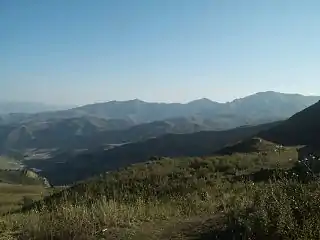 Scenery
Scenery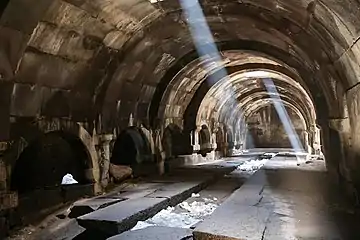 Inside Orbelian's Caravanserai
Inside Orbelian's Caravanserai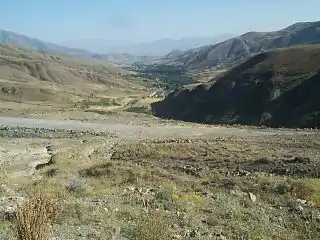 Scenery
Scenery
References
- 1 2 Statistical Committee of Armenia. "The results of the 2011 Population Census of Armenia" (PDF).
- ↑ "RA Vayots Dzor Marz" (PDF). Marzes of the Republic of Armenia in Figures. 2009. pp. 264–270. Retrieved 27 June 2023.
- ↑ Kiesling, Brady (June 2000). "An Archaeological/Touristic Gazetteer and Map Set for the Historical Monuments of Armenia" (PDF). Retrieved 16 February 2021.
- ↑ "Centre of Geodesy and Cartography" SNCO under Cadastre Committee of the Republic of Armenia (2008). Dictionary of settlements of the Republic of Armenia (PDF). Yerevan. p. 184. Archived from the original (PDF) on 9 February 2020. Retrieved 6 July 2023.
{{cite book}}: CS1 maint: location missing publisher (link)
External links
- Report of the results of the 2001 Armenian Census, Statistical Committee of Armenia
- Kiesling, Brady (2005), Rediscovering Armenia: Guide, Yerevan, Armenia: Matit Graphic Design Studio
- Kiesling, Brady (June 2000). Rediscovering Armenia: An Archaeological/Touristic Gazetteer and Map Set for the Historical Monuments of Armenia (PDF). Archived (PDF) from the original on 6 November 2021.
